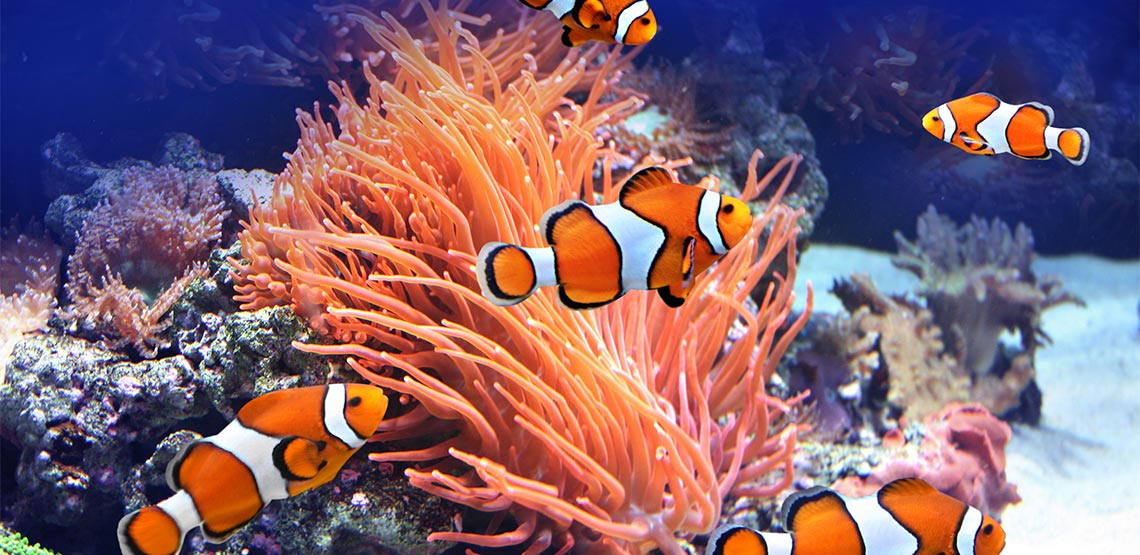
Your Saltwater Playground
With your saltwater tank all set up, stabilized, and ready to take on the addition of underwater guests, you’re now ready to pick out some fish. There are many saltwater creature to choose from, but finding the right ones for your aquarium will be based on a few thing: the size of your tank, and whether or not the species you want can cohabitate.
It’s always best to research any live additions you’re interested in adding to your aquarium. Basing this decision on color and appearance alone could end up leaving you disappointed.
This list has broken down some of the more popular saltwater fish that hobbyists choose, and outlines the level of commitment that goes into their daily care. Both beginners as well as advanced saltwater aquarists are sure to find many options when it comes to selecting the right fish.
Beginner Level: Clownfish
These familiar fish have always caught our attention with their brilliant orange and white coloration. Even more spotlight fell on these fish once Nemo swam into the hearts of adults and children alike. The Ocellaris (False Percula) Clownfish is what you’ll come across the most, as this species is readily bred.
They grow to a reasonable 3.5 inches, have an omnivorous diet (meaning they will eat both plants and animals), and tend to be quite peaceful. They don’t require a lot of space, but they will appreciate corals, anemones and other decor to hide among and establish territories.
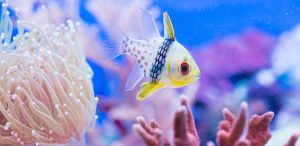
Beginner Level: Pajama Cardinals
Cardinal fish tend to be a little underrated. Their peaceful nature and bold markings make these fish an excellent addition to a community saltwater tank. As carnivores, they will enjoy foods such as mysis shrimp, bloodworms, brine shrimp, pellets, and more. These fish like to school, so keeping them in groups of four, at the very least, will help ensure their happiness.
Make sure to provide these fish with plenty of hiding places, such as rocks and seagrass.
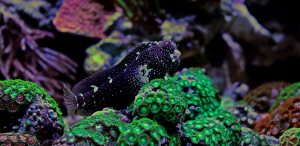
Beginner Level: Blenny Fish
Blennies are adorable bottom dwellers that have no problem finding the best hiding places. These peaceful fish will cohabitate well with many other species, except other Blennies. Unfortunately, housing more than one of these fish together typically results in them constantly fighting over the same hiding spots.
Depending on the species of Blenny you go with, sizes can range anywhere from 2 to 5 inches in length. As well as size, different Blenny species have varying food preferences. Some are carnivores, others herbivores, and then there are those in between who are ready to eat anything! You’ll find that most will happily scoop up food scraps on the bottom of the tank as they sift through the sand.
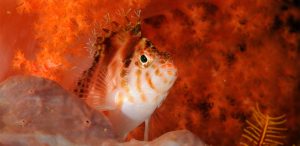
Intermediate Level: Hawkfish
There are a few species of Hawkfish, all of which are considered to be semi-aggressive. These beautiful fish can certainly add color and personality to your tank, especially if you choose the vibrant Flame Hawkfish. The various species of Hawkfish range from 3 to 5 inches as adults, but don’t let their smaller size fool you.
Hawkfish are mostly bottom dwellers and tend to become territorial when it comes to their space, and favorite pieces of coral. If you’re planning on keeping your Hawkfish with other bottom dwellers, including other Hawkfish, you will want to ensure you have a large enough tank to avoid unnecessary stress and loss of smaller fish.
As carnivores, the Hawkfish will enjoy eating all sorts of shrimp, bloodworms, pellets and even flakes. You’ll find them hunting among their corals so they can make a quick escape if they feel threatened.

Intermediate Level: Butterfly Fish
Gorgeous, colorful and sure to turn heads, the Butterfly Fish is an option for large tanks that don’t have live corals. These fish like to pick off the invertebrates that are needed to keep corals in good condition, and some corals may even harm the fish if they are kept in too small of a space.
Besides making sure the tank you have is large enough, a common hurdle with keeping Butterfly Fish is that they can be quite particular about what they eat. It’s good to be able to observe this fish before purchasing to witness how they interact with different foods.

Intermediate Level: Lionfish
The Common Lionfish (Volitan Lionfish), will be front and center in your aquarium. These fish tend to like to spend most of their time swimming in open water. They can grow to be anywhere from 10 to 15 inches as adults and have a rather long lifespan. Besides tank size requirements, these fish fall under the intermediate level because they are master carnivores.
These fish are designed to eat other fish, so trying to keep them with any other types of fish (that you don’t want eaten) will be difficult. There’s also the matter of those beautiful spines, as they are filled with toxin. Their venomous sting will cause immense pain, and may even prove fatal (if you’re allergic, that is), so tank maintenance should be conducted with extreme care.
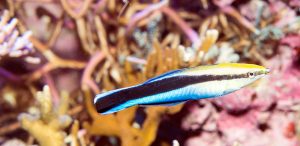
Advanced Level: Cleaner Wrasse
This is often a saltwater fish that beginner aquarists end up with, as they are fantastic for clearing up ich outbreaks. The problem later presents itself when the Cleaner Wrasse no longer has parasites to feast upon. With no food and limited space, this normally passive fish becomes a bully, and will harass other tankmates with the hope that they carry parasites to feed on.
However, these fish have been successfully housed by advanced hobbyists. The trick is feeding them in small quantities, as they do not have the ability to take in large amounts of food at once. Mysis shrimp, brine shrimp, spirulina, nori, and tiny marine pellets are suggested as food options.
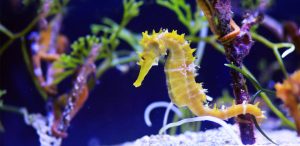
Advanced Level: Seahorses
The trade of these phenomenal creatures is regulated by international law, however, it is not prohibited to own them. You will want to look for those that are captive bred as opposed to “tank-raised,” “net pen raised,” or those caught from the wild. These graceful, fragile creatures readily eat up mysis and brine shrimp, however, they eat a lot.
It can be difficult to balance the right amount of food to fill them with while not polluting your tank with excess. Seahorses do best in a species-specific tank without live reef setups, where their slow movements and need for gentle currents aren’t influenced by fellow tankmates.
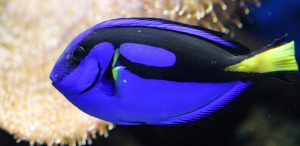
Advanced Level: Tangs
Tangs come in several shapes, sizes, and colors. They love to swim around and have a lot of open space, meaning they will thrive in a very large tank. These fish often catch the eyes of those who aren’t ready to take on their vivaciousness and need for space.
However, with the right set up, Tangs will provide all sorts of entertainment with their antics. Another trait to note with Tangs is that they have a thinner slime coat than most, making them more susceptible to disease. Most are herbivores, and enjoy a steady diet of algae.
It’s best to always do species-specific research for the exact fish you are looking to add to your saltwater aquarium. Keep in mind that while a saltwater tank may be challenging to maintain, it is a very rewarding and enriching addition to any home or office.
Are you ready to take the plunge?
